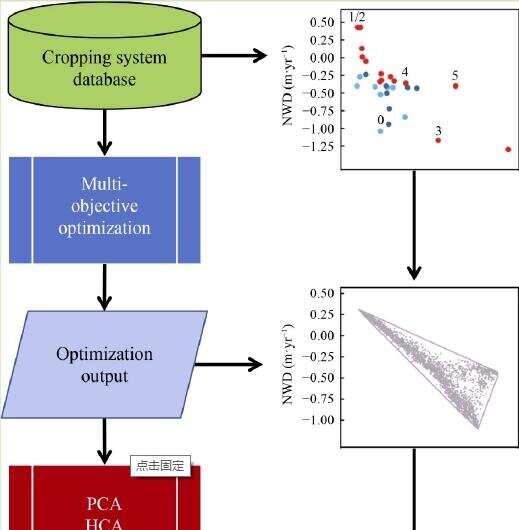A new design of sustainable cropping diversifications

Cropping systems are one of the most important components in the crop production system, which is intensified to feed a growing global population. Previous studies focused on high yield with less attention to production of nutrients and vitamins for human diet. Since the Green Revolution, a winter wheat-summer maize double cropping system has dominated the North China Plain (NCP), with the increasing inputs of fertilizer, pesticides and irrigation for high grain production for food security, resulting in the sharp depletion of groundwater and a series of environment problems such as water pollution.
In order to meet multiple objectives for high yield and good quality plus less groundwater withdrawal, scientists from Wageningen University & Research and China Agricultural University cooperated and established a multi-objective optimality model to create a new configuration for the 30 kinds of diversified cropping systems practiced in the NCP at the regional level to coordinate the trade-offs between indicators of economic, food security, and environmental performances. Their study was published in Frontiers of Agricultural Science and Engineering.
Based on the established cropping systems database compiled by Yang et al. (2021), Jeroen C. J. Groot (Wageningen University & Research) and Yang (China Agricultural University) comprehensively evaluated the performance of 30 crop rotations for multiple indicators, including yield, economic benefits, groundwater consumption, vitamin C, dietary energy and feed yield. Principal component analysis (PCA) and hierarchical cluster analysis (HCA) were used to get the potential multi-objective cooperative cropping systems. The evolutionary algorithm of differential evolution and Pareto optimization model were used for multi-objective optimization to get the reconfiguration of diversified cropping systems with multi-objective trade-offs and synergies on the regional level.
Their results indicated that the performances are different among different cropping systems on the abovementioned evaluated indicators. There was synergic relationship between economic revenue and dietary nutrition, diet energy, and feed product, but it occurred with the decline of groundwater. Vitamin C had a negative correlation with forage products. Therefore, it is crucial for regional planting structure adjustment and optimality to consider the multi-objective tradeoffs and synergetic evaluation to meet the requirement of people for better and healthier life.
Considering the multi-objective tradeoff and synergy of groundwater level decline, dietary energy, economic benefits, vitamin C and feed output, the researchers put forward optimization solutions for planting structure reconfiguration based on diversified cropping systems rather than the simple planting area of a certain crop. This is a novel and important viewpoint of their study. It is suggested that the planting structure optimization should directly focus on and act on the potential cropping systems instead of the simplex crop sowing area in the future study. China is a typical country for multiple cropping systems, which enhances system productivity by increasing the cropping index. It is significantly important to fully consider the temporal and spatial configuration of different crop rotations and crop combinations.
Therefore, they proposed a new perspective for regional planting structure adjustment.
(1) It should conduct a multi-objective integrated evaluation on cropping systems, considering multi-dimensions of grain yield, economic benefit, green environment, health diet and soil health, which positively promotes the sustainable development of farming system.
(2) It should increasingly improve and update the optimization algorithm, such as genetic algorithms, Monte Carlo simulations, fuzzy programming algorithms and Pareto multi-objective optimization, directly targeted for the cropping system rather than the simple planting area of one certain crop. The study object focuses on diversified cropping system optimality implied the time and space-scale configuration of crops at reginal scale. The Farm Design Model (Groot et al., 2012) based on Pareto optimization employed by their study is proven to be a good tool for crop reconfiguration, which supplies the important references for policy-makers to adjust the planting structure at different scales.
(3) It is also urgent to pay attention to the multi-objective optimization and reconfiguration of cropping systems under future climate change scenarios to increase the resilience of the farm system.
More information: Jeroen C. J. Groot and Xiaolin Yang, Trade-Offs In The Design Of Sustainable Cropping Systems At A Regional Level: A Case Study On The North China Plain, Frontiers of Agricultural Science and Engineering (2022). DOI: 10.15302/J-FASE-2021434
Provided by Higher Education Press




















